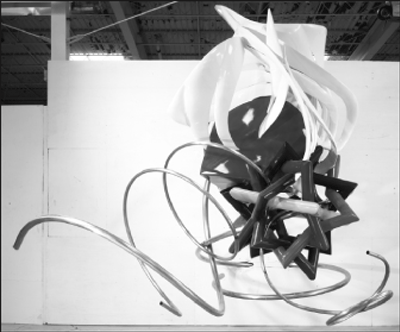By Stephanie Murg
Undulating. Exuberant. Bouncy. These may not be the first three words that one associates with Frank Stella, who is best known for his flat painterly surfaces (in pitch black, aluminum, and copper), shaped canvases, and shoulder-shrugging Minimalist dictum, “What you see is what you see.” However, these are the words that best describe most of the 17 new works by Stella that fill Paul Kasmin Gallery.
This is the summer of Stella sculpture. The Metropolitan Museum has given the 71-year-old artist both his first solo exhibition there (“Frank Stella: Painting into Architecture,” through July 29) and plum rooftop placement for several more of his recent works that walk the blurry border between sculpture and architecture. The works at Paul Kasmin, at least the 15 that were completed in 2006 and 2007, are notable for their buoyancy, nimbleness, and the occasional pops of cartoon colors that propel the whirls of stainless steel tubing and cast aluminum beyond the realm of hardware store tinkering.
In the gallery’s first room, “K.34 (large version)” (2007) hovers over the floor. It is a day-glo crumple of fiberglass, foam, and tubing impaled on a couple of curving, silvery vertical bars. One component of the sculpture, a honeycombed shell spray-painted fluorescent pink, resembles a massive bike helmet, while the piece that swirls down from the ceiling could be the surfboard-colored skin of a skillfully peeled giant apple. It is this work that most closely recalls Stella’s enduring fascination with an ingenious sun hat that he discovered on the beaches of Rio de Janeiro a few decades ago. Made entirely of foam, the hat is sliced in a curving pattern that allows it to expand to fit any head in a comfy cage of strips and then collapse back into a flat disc. Frank Gehry would approve.
Over the years, this quirky Brazilian hat, along with the work of such German architects as Bruno Taut, has inspired many of Stella’s three-dimensional works, and another sculpture in this show is a rare synthesis of these influences. “K.3 (large version)” (2006) is dominated by coiled stainless steel tubing that unfurls to greet the viewer in the gallery’s second room. Caught in the metal springs is a rainbow-colored polyhedron that recalls the early utopian leanings and a favored color scheme of Taut. Lodged just above the solid, Everlasting Gobstopper-like object is a constellation of white strips that twist in harmony with the coils below, so as to suggest that the work would happily bounce right down 10th Avenue if it could only fit out the door.
The gallery’s back room is something of a downer. The 1999 work “Catal Huyuk (Level II) Shrine A.III.1” is a hulking, earthbound structure of cast aluminum and stainless steel. Named for an ancient Turkish culture and interestingly, a nine-foot-long wall painting that is considered one of the world’s first maps, the work favors soldered metal and ridged, arterial pipes over lithe, shiny tubes and brightly-colored fiberglass. One thick, swooping curve that juts out of this work’s center, however, is mind-blowing, with the elegance and confidence of an ocean liner’s anchor.
While this summer of Stella may lead some to shake their heads and pine for the works that laid flat against the wall rather than those that dangle from menacing metal hooks yet threaten to float away, the artist’s latest work achieves a new sense of lightness that is the product of spirited color infused into organic shapes that are often executed on a monumental scale. Critic David Anfam said it best in his review last year of the exhibition of work produced by Stella in 1958. Commenting on the breadth of the artist’s career, Anfam suggested that perhaps “Stella’s sole fault is to have been a dedicated risk-taker.”




































